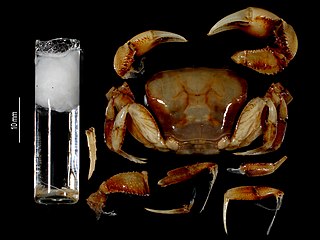
Dragonets are small, percomorph, marine fish of the diverse family Callionymidae found mainly in the tropical waters of the western Indo-Pacific. They are benthic organisms, spending most of their time near the sandy bottoms, at a depth of roughly two hundred meters. There exist 139 species of the fish, in nineteen genera.

Synchiropus splendidus, the mandarinfish or mandarin dragonet, is a small, brightly colored member of the dragonet family, which is popular in the saltwater aquarium trade. The mandarinfish is native to the Pacific, ranging approximately from the Ryukyu Islands south to Australia. It can usually be found in some of the warmer waters.
Victor Gruschka Springer was an American biologist who was a Senior Scientist emeritus, Division of Fishes at the Smithsonian Institution's National Museum of Natural History in Washington, D.C. He was a specialist in the anatomy, classification, and distribution of fishes, with a special interest in tropical marine shorefishes. He published numerous scientific studies on these subjects; also, a popular book called "Sharks in Question, the Smithsonian Answer Book" 1989.
Dr. Jack Thomson Moyer was a marine biologist and known child sexual abuser from Kansas, who lived for most of his life on Miyake-jima in Japan. Moyer was a scientist with the United States Air Force, who became a teacher later in life for the American School in Japan (ASIJ). He committed suicide in 2004. After his death, multiple allegations surfaced that Moyer had sexually molested students during his tenure at the ASIJ.

The Ethiopian amphibious rat, also known as the Ethiopian water mouse, is an insectivorous and semiaquatic species of rodent in the monotypic genus Nilopegamys of the family Muridae. There has only been one known specimen. It was found along the Lesser Abay River near its source at an altitude of 2600 m in the highlands of northwestern Ethiopia in 1928. N. plumbeus is considered to be the most aquatically adapted African murid; its unusually large brain is thought to be one consequence of this lifestyle. The species is considered to be critically endangered or possibly extinct, since its habitat has been severely damaged by overgrazing and monoculture.

The Vanikoro flying fox, also known locally as the basapine, is a species of bat in the family Pteropodidae. It has only been found in the Vanikoro island group located in the southern Solomon Islands. The species as a whole was originally known from just a few specimens collected sometime before 1930 but following surveys conducted on the island in the early 1990s did not detect this species again causing the Vanikoro flying fox to be listed as extinct. However, the species was rediscovered by a survey conducted in late 2014 which indicated a population in the high hundreds or low thousands and reported all observations.

Afrithelphusa is a genus of freshwater crabs in the family Deckeniidae. It contains four species, all of which were formerly listed as critically endangered by the International Union for Conservation of Nature (IUCN). They are all endemic to the Upper Guinean forests of Guinea and Sierra Leone.

The ocellated dragonet or scooter dragonet is a species of tropical marine fish in the family Callionymidae. It is native to the southwest Pacific Ocean from southern Japan to the Marquesan Islands.
The spotted dragonet is a species of dragonet native to the eastern Atlantic Ocean and the Mediterranean Sea where it occurs at depths of from 45 to 650 metres. This species is important to local peoples engaged in subsistence fishing.
Ecsenius ops, known commonly as the eye-spot blenny or the yellow-eye combtooth-blenny in Indonesia, is a species of combtooth blenny the family Blenniidae.

Heniochus chrysostomus, also known as the threeband pennantfish, threeband bannerfish or pennant bannerfish, is a marine ray-finned fish, a butterflyfish from the family Chaetodontidae.It is found in the Indo-Pacific region.
Synchiropus sechellensis, the Seychelles dragonet, is a species of marine ray-finned fish, a dragonet from the family Callionymidae. It is found in the Indo-Pacific from the Red Sea south to the Seychelles and the Maldives and east as far as New Caledonia. Following a likely introduction via the Suez Canal, it was first recorded in the Mediterranean Sea in 2014; where it is found on rare occasions from Alexandria (Egypt) to the Gulf of Antalya (Turkey).

Synchiropus phaeton or the Phaeton dragonet is a species of bony fish of the family Callionymidae, the dragonets. It can be found in the Mediterranean and in the eastern Atlantic.
Synchiropus circularis, the circled dragonet, is a species of fish in the family Callionymidae, the dragonets. It is found in the Western Pacific.
Synchiropus claudiae, the Claudia's dragonet, is a species of fish in the family Callionymidae, the dragonets. It is found in the Western Central Pacific.
Synchiropus grandoculis, the Western Australian bigeye dragonet, is a species of fish in the family Callionymidae, the dragonets. It is found in the Eastern Indian Ocean along Western Australia.
Synchiropus minutulus, the minute flagfin dragonet, is a species of fish in the family Callionymidae, the dragonets. It is found in the Western Indian Ocean.
Synchiropus randalli, the Randall's dragonet, is a species of fish in the family Callionymidae, the dragonets. It is found in the Southeast Pacific off of Chile.
Synchiropus grinnelli, the Philippines dragonet, is a species of fish in the family Callionymidae, the dragonets. It is found in the Western Central Pacific from Philippines to Indonesia.
Synchiropus laddi, the Ladd's dragonet, is a species of fish in the family Callionymidae, the dragonets. It is found in the Pacific Ocean.








